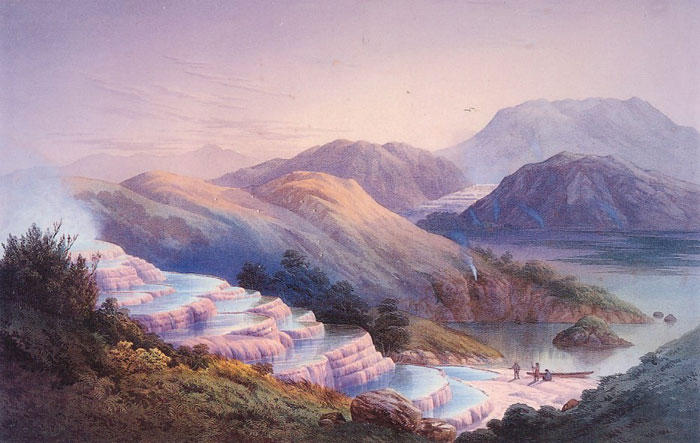 [Image: Courtesy of the Alexander Turnbull Library, via ScienceDaily].
[Image: Courtesy of the Alexander Turnbull Library, via ScienceDaily].
—Autonomous underwater robots in New Zealand have discovered a submerged geological feature that was once described as a Wonder of the Natural World, before it was buried by a volcanic eruption.
—Street thieves in Johannesburg are stocking their cell phones with SIM cards stolen from traffic lights—or municipal infrastructure repurposed as telecommunications technology. The city broken apart and turned into private telephones.
—”New York’s central nervous system is growing.” Earlier: NYNEX, Embedded Angel of New York City.
—New York City has hired its first Chief Digital Officer, Rachel Sterne. Sterne has the official goal “of improving communication with residents and businesses by enhancing government transparency and working closely with digital media… Sterne is tasked with helping to make NYC.gov more user-friendly, ensuring that agencies integrate social media opportunities and serving as an advocate for the digital media industry in New York City.” Information is public infrastructure.
—On Chicago and New York as emerging hubs in a climate-changed world.
 [Image: Watts Towers photographed by Michal Czerwonka for The New York Times].
[Image: Watts Towers photographed by Michal Czerwonka for The New York Times].
—Are the Watts Towers doomed by California’s precarious finances? Earlier: Crash State.
—La Cité du Pétrole, a documentary about the “largest offshore oil town ever built.” Known as Oil Rocks it is a vast, sprawling web of oil platforms in the middle of the Caspian Sea, commissioned by Stalin in 1949,” with “2,000 oil rigs, 300 kilometres of bridges, rusty old Soviet trucks rolling back and forth, nine-storey building blocks, thousands of oil workers, a cultural palace, a lemonade factory, a green park.” Earlier: Oil Rocks.
 —On Thursday, February 10, at Ronald Feldman Fine Arts in New York City, the Nevada Museum of Art’s Center for Art + Environment will announce the line-up for its forthcoming 2011 fall conference.
—On Thursday, February 10, at Ronald Feldman Fine Arts in New York City, the Nevada Museum of Art’s Center for Art + Environment will announce the line-up for its forthcoming 2011 fall conference.
—Friends of the Pleistocene is seeking papers about the influence of geology on human popular culture, or what they call “the geologic turn in contemporary cultural practices.” You have till March 1 to submit proposals.
—”Yellowstone National Park’s supervolcano just took a deep ‘breath,’ causing miles of ground to rise dramatically, scientists report… ‘It’s an extraordinary uplift, because it covers such a large area and the rates are so high,’ said the University of Utah’s Bob Smith, a longtime expert in Yellowstone’s volcanism.” Earlier: A bulge in the floor now 100 feet high.
—”The best way to manage national parks in the face of the effects of climate change is not to manage at the park level, but to work with [entire] landscapes.” Thus the growing interest in corridor ecology: “This is why conservation biologists, since at least the early 1990s, have called for parks to be connected to one another by unbroken corridors of nature, through which large species can move. For small mobile species, such as birds and insects, a stepping-stone scatter of protected areas close to one another has much the same effect… In particular, sites with microclimates to harbour species that can’t take the heat need to be identified, protected and linked to existing protected areas.”
—Archaeologists in the UK might soon be required by law to re-bury many of their finds. “The dispute centres on legislation introduced by the Ministry of Justice in 2008 which requires all human remains excavated at digs in England and Wales to be reburied within two years, regardless of their age.” Earlier: Catch-and-Release Archaeology.
 [Image: Photo by Paul Bryan, courtesy of the Guardian].
[Image: Photo by Paul Bryan, courtesy of the Guardian].
—”Cutting-edge space science technology of the sort used to analyse moon rock is being applied to fragments of 16th-century tombs. Scientists from the Space Research Centre in Leicester are working with an art historian from the nearby university as well as academics from Oxford and Yale in a three-year project that hopes to shed new light on our understanding of the Tudor Reformation.” There’s something endearing about a species so desperate for historical knowledge about its own that it resorts to studying its own cultural artifacts with instruments first designed for exploring other planets.
—Finally, a family in China was stranded inside their home after property developers “demolished every staircase in a seven-storey apartment block to make them quit their top floor flat.” “The only way we can get out now is through ladders and climbing but it is very dangerous,” one of the family members told the media.
(Some links via @eatingbark, @doingitwrong, Archaeology News, Simon Fagéus, a commenter named SED, and more).
